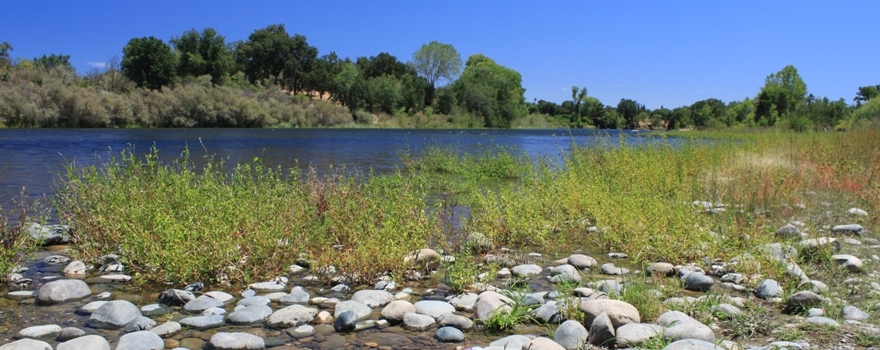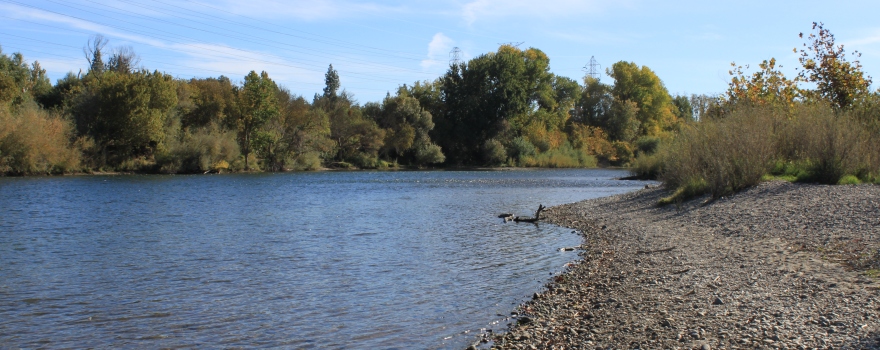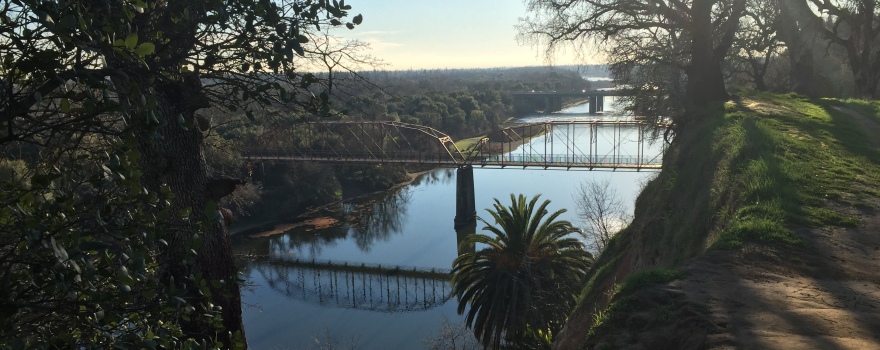An interview with Water Forum Executive Director Jessica Law on climate change, equity and shaping a groundbreaking agreement for the next 20 years
Article written by Matt Weiser
The Sacramento Water Forum is a unique organization founded around the idea of protecting a wild and scenic river in the heart of California’s capital city. Nearly 30 years after its founding, the group has achieved considerable success, and is now working towards an agreement that will last the next few decades.
Key to that success was the signing of the Water Forum Agreement in 2000, a collaboration between agricultural and business leaders, environmentalists, citizen groups and more than two dozen urban water agencies and local governments. It took seven years of work, but the agreement set protection and enhancement of the Lower American River as a primary objective. The agreement also assured participants that achieving sustainable water supplies was a primary objective. It was one of the first major water-sharing deals achieved in California without court intervention.
Twenty years later, the river is healthier and the diverse Water Forum interests are collaborating more closely than ever to steward and share the region’s water supplies, both in the river and below ground.
Now, the Water Forum has a new executive director, Jessica Law, who is working to update the agreement. Law has 15 years of experience in water and environmental management, land use planning and collaborative decision making. In the interview summarized below, she spoke about the process of updating the landmark agreement, which she refers to as Water Forum 2.0.
What is Water Forum 2.0?
 Jessica Law: It’s a refreshing of the original Water Forum Agreement. The original deal took seven years, from 1993 to 2000, amid tremendous controversy over water rights. It’s been in place 20 years now. The water providers still call it their “North Star,” and it has proven its worth. But the agreement ends in 2030, so we have nine years to redo the agreement. My goal is to get it done in three years. We recognize the agreement is solid, but things have changed a lot. So it’s time to take a look at what’s coming and what we want to do about it.
Jessica Law: It’s a refreshing of the original Water Forum Agreement. The original deal took seven years, from 1993 to 2000, amid tremendous controversy over water rights. It’s been in place 20 years now. The water providers still call it their “North Star,” and it has proven its worth. But the agreement ends in 2030, so we have nine years to redo the agreement. My goal is to get it done in three years. We recognize the agreement is solid, but things have changed a lot. So it’s time to take a look at what’s coming and what we want to do about it.
It seems appropriate, somehow, that this process is unfolding as another severe drought grips the state.
Ms. Law: To the extent the new Water Forum agreement is looking at water sustainability, we are writing that chapter this year. We’re looking at how to respond to drought, and be more resilient.
But at some point, nature is moving faster than we can keep up. This year, with another extreme drought in play, is a great example of that. We had better water storage in all reservoirs coming out of a dry year than we ever had. This was very intentional by Reclamation and the Department of Water Resources. Still, we’re in a really bad situation this year. The general population is experiencing climate change now in a way that’s very real.
We learned a lot from the last drought in 2013-15 and have improved the way we work. Water managers are working smarter and faster, we have better monitoring, modeling and forecasting tools. Water purveyors are not just relying on Folsom Reservoir anymore. They have backups, interties, and stored groundwater. And for the most part, residents have sustained a pattern of decreasing water use through efficiency and conservation.
Are changing priorities in the region affecting the shape of this new agreement?
Ms. Law: Well, we also know a lot more now about how to grow a region sustainably. We’re growing a lot slower than what was projected in the 2000 Water Forum Agreement. There was an assumption of full buildout in the region by 2050. But we’re nowhere near that. We still have a growing population and demand for water. But as a region we’re focused on shifting to a more sustainable land use pattern, as opposed to just expanding and expanding. For example, the city of Sacramento is focused on infill and affordable housing, and transit oriented development.
On the water side, we’re getting there. We’re figuring out how to think about the watershed and using groundwater to support reliability. The biggest thing we’ve done is develop and implement a Modified Flow Management Standard with Reclamation that governs water movement in the Lower American River and optimizes conditions for fish. So that’s huge.
Also, we’re doing our 10th restoration project in the Lower American River now. We have more that we have to do, but the restoration work that has been done since 2000 has measurably improved habitat conditions in the river for steelhead and fall-run Chinook
What are you doing to redefine the culture of the organization with the future in mind?
Ms. Law: For any organization, defining the way we work is important, because it creates identity and culture.
For the members who have been part of the Water Forum for the past 20 years, they often talk about “The Water Forum Way,” which was created as a result of the very intense seven-year negotiation to get to an agreement. Trust is a skill, and it’s central to “The Water Forum Way”: How to be collaborative, what to do if someone gets defensive, how to demonstrate accountability and model good communication skills. That’s how we achieve what we want to achieve.
We also have a lot of new members, too, including me. So we have to work to define our core values or principles. Those include bringing together diverse interests; creating continuity; building on existing successes; addressing drivers of change — including climate change; increasing awareness and public understanding; creating mutual benefit and support; assuring coordination; and acting with a sense of urgency.
You’ve said Water Forum 2.0 is also about increasing diversity and social equity. How are you doing this and why is it important?
Ms. Law: The Water Forum has always had a foundation of seeking out diverse interests and perspectives. But there is an outstanding question: “How do we more clearly articulate, embed, or draw out social equity in our work”? The four caucuses that make up the Water Forum – business, environmental, water, and public – often represent a wide range of interests and positions. But that’s different from seeing the issues from the perspective of communities of color; tribal communities; and those who don’t have the same access to the parkway or educational opportunities.
Generally, this region provides access to safe and affordable water for its residents, but there are pockets where more needs to be done to improve that access and affordability. So, we are talking about it. And we have a lot more listening and learning to do.
What’s happening in the larger world of water/environmental management that’s driving this? Is there a lack of diversity?
Ms. Law: Yes, absolutely there is a lack of diversity in the world of water and environmental management! It has been traditionally a white male dominated profession, but that is changing rapidly.
In the Sacramento region there are some excellent role models and notable women in positions of influence and leadership. For example: Karen Ross, California Department of Food and Agriculture secretary; Felicia Marcus, former chair of the State Water Resources Control Board; and Karla Nemeth, director of the Department of Water Resources.
Right now, the Water Forum staff is all female, and we work with a lot of absolutely brilliant, passionate, smart, savvy women in the field as well. And there are more networking opportunities for women—Association of Women in Water, Energy and Environment; Leadership California; and the Water Education Foundation—that support the next generation of leaders.
Diversity is important for a lot of reasons. We know that the more diverse a group is, the better it is at problem solving, coming up with creative solutions, and getting through crisis. The water management world is shifting strategies, becoming more collaborative, more holistic, and making space for more voices.
But we can’t stop yet. We need to make sure water management and environmental management are accessible and create opportunities to welcome people of color, tribes, and those from diverse backgrounds and experiences to engage in this work.
What does the Lower American River represent to you? What does it represent to the community? To the state?
Ms. Law: I’m sure you’ve heard the Lower American River described as the “crown jewel” of Sacramento. I totally agree. Everywhere I’ve lived, I always look for those small pockets of wild in the middle of the city or town. It’s a place to reset, relax, and get away from it all – and it doesn’t have to be that grand to be special.
But this place, the river, it’s exceptional. It’s a wild edge to our dynamic city. And it’s there for everyone: unhoused, families, fishermen and women, dogs (lots of them), plus turkeys, coyotes, birds, wild partiers, fish, the list goes on. That’s part of the beauty too.
Maybe you’ve seen the poster around Sacramento that says, “Every day is your chance to make this city a little better.” It’s by local artist Alex Trujillo. That poster captures my “Why”: Every day in this job, I have the chance to make this city better by protecting the American River, informing decisions for the absurdly complex water supply system in the state, and getting restoration projects done in the river.
As for the state, well, there are a lot of very special places like this around California. The Lower American River, and the Water Forum in particular, are an incredible example of how a community can come together to protect its wild places. From the statewide perspective, it’s important to keep sharing stories about how communities can do that work. It’s hard work, but worth it.





